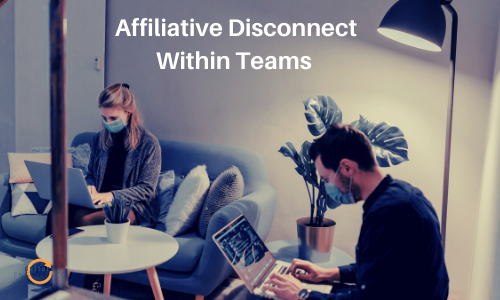What is affiliative disconnect?
Have you ever been in a room, surrounded by people, only to still feel lonely? According to Cigna research, 61% of the people in that room with you likely felt the same way. This is because loneliness different from togetherness because it’s irrespective of the physical presence of others, occurring when we lack the feeling of meaningful connection with others. Affiliative disconnect is a feeling of isolation or loneliness that develops collectively within a team, despite being part of a group. While affiliative disconnect, like loneliness, may be hard to see, the symptoms are clear and can derail even the strongest of companies if not addressed.
Is your team struggling with affiliative disconnect?
Teams experiencing affiliative disconnect left unaddressed will eventually turn toxic. The key is detecting signs of team affiliative disconnect early. Some of the most commonly observed warning signs include:
- Higher than normal turnover (particularly high turnover with new hires – less than 90 days of employment).
- Increased/high absenteeism.
- Poor team performance (particularly with customer-facing roles such as sales or customer service).
- Distrustful behaviors within the team such as passive aggressive comments, finger-pointing, hostility, and/or intentionally withholding information.
- A lack of interaction or camaraderie among team members. In more extreme situations, team members will often know very little about one another, despite having worked together for a significant period of time.
How to (re)ignite connection within your team.
As social creatures, we as humans take to high connection interactions like fish to water. Even individuals and teams that have survived for extended periods of time without meaningful connection are highly resilient. Here are three basic ways every leader can take to help restore connections within their team:
#1 – Make individual wellbeing the priority, for the team.
It’s an unfortunate truth that hurt people, hurt people. Although not quite as catchy, the same concept works conversely. Individuals with a healthier sense of wellbeing when working together, tend to make better teams, associated with higher job satisfaction, better company stock performance, improved productivity and customer loyalty, and reduced turnover. Research shows lonely workers are less productive and more frequently sick which can wreak havoc on any business. More importantly however, people with poor mental health and wellbeing were three to six times more likely to report frequent loneliness. Because research has also found a lonely person can transmit loneliness to others, wellbeing offers a solution to prevent the harm caused by loneliness in our workplaces and communities.
#2 – Encourage and recognize supportive behaviors within the team.
There is a popular legend of unknown origin, often attributed to the Cherokee or Lenape people, that begins with a grandfather telling his grandson of a battle of two wolves going on inside him. The grandfather describes one wolf as evil – driven by anger, jealousy, and ego, and the other good – motivated by love, generosity, and compassion. When asked by his grandson which wolf will win, the grandfather responds, the one you feed. This same battle happening within each one of us individually is also happening within our teams. When we recognize the supportive, prosocial, behaviors that are foundational to collaboration and communication within teams, we are feeding the good wolf. Because recognition has been shown to affect two areas of the brain: 1) our hypothalamus, the part of our body responsible for regulating many of the body’s key processes, such as heart rate and body temperature, and 2) our dopamine receptors which receive dopamine, the chemical that affects mood, sleep, memory, learning, and concentration, recognition has been shown to have tangible benefits on a team and virtuous benefits on individuals.
#3 – Co-create team culture.
Historically, culture was often something defined by a few leaders, perhaps with the help of outside consultants or HR, and distributed in a top-down fashion. More recently however, with growing appreciation and value for diversity and inclusivity, we’re realizing the previously one-to-many approach is far surpassed by the approach of many-to-many. It’s only when environments are inclusive, engaging the voices thoughts, and talents of diverse groups, that communities thrive. A co-creative workplace culture not only embraces but implores feedback and transparency. With the development of our newest tool, TeamEthos.io, it was the introduction of the team notifications, informing team members of how the team was doing that day and what each person can support one another in the moment, that we saw the biggest shift in team connection and success. Empowering a team to identify and solve for challenges within a process or system can be a great first step toward building psychological safety and collaboration, the foundation of any co-creative, highly connected culture.
Affiliative disconnect isn’t the sickness. It’s a warning sign that the health of your team is in jeopardy. The danger comes only from ignoring it. It’s taken the Covid pandemic to reveal another potentially harmful pandemic we’re all susceptible to, loneliness. Not everyone comes from a healthy family environment. Many struggle to create a healthy network of friends. But most of us, in our lifetimes will need to work. What if we, as leaders, make work the safe space we intentionally create meaningful connection?
